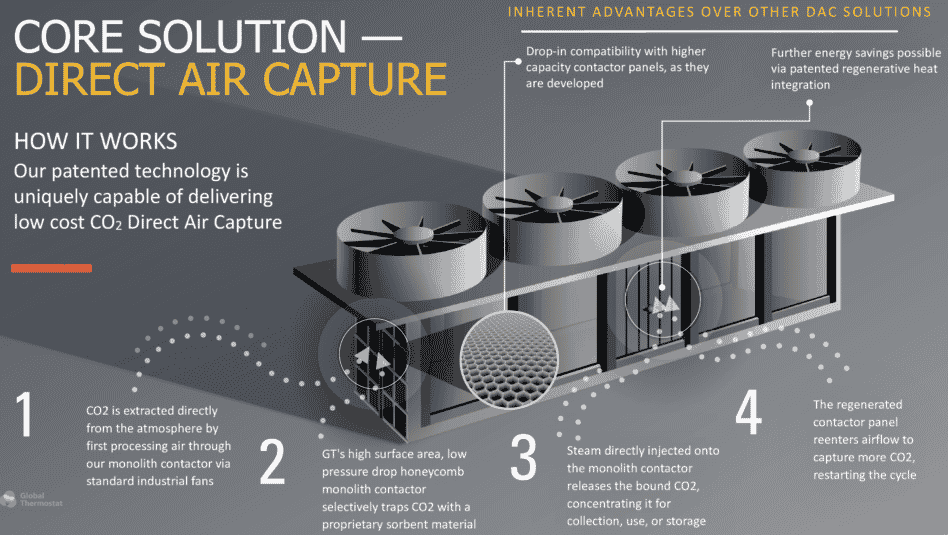Global Thermostat unveiled one of the largest direct air capture (DAC) units in the world but the company is still working out what to do with the CO2 it captures.
The huge commercial-scale DAC facility is operating in Brighton, Colorado with giant fans sucking CO2 directly from the sky. It is one of the world’s biggest DAC machines but the carbon it captures returns back to the atmosphere.

Commenting on the launch, Global Thermostat’s CEO, Paul Nahi said:
“We are already in discussions with multiple partners about moving from kiloton to hundreds of kilotons in the next couple years and then shortly thereafter move to the megaton scale… We can avoid this [climate change]. There is still time. But we have to act now.”
Global Thermostat DAC Launch
Global Thermostat DAC project, which started operation in late 2022, can capture 1,000 metric tons of carbon each year. But the company is still looking for an off-taker for the captured CO2 that the machine is releasing back into the atmosphere right now.
The off-taker can be another company that stores captured carbon underground or uses it to create products like concrete.
The DAC company prioritizes getting the unit to work on a commercial scale. Other steps are still in progress such as where to store and transport the captured CO2.
Global Thermostat’s DAC launch was attended by top government officials, including the state’s previous governor and representatives from the White House.
The Role of DAC in fighting climate change
Direct air capture is in its early stages and the existing technologies are still costly and energy-intensive to operate. But industry experts believe that DAC has a crucial role to play in fighting global warming and climate change.
The recent UN climate report strongly indicates that the earth has to remove, on a gigatons scale, carbon and store it. But the report’s authors noted that carbon removal methods must work instantly and significantly cut GHG emissions.
In the U.S., billions have been invested by the government in developing and constructing giant air filters. Investments from the private sector in carbon removal technologies are also soaring. And DAC has been the most popular removal technology that is gaining a lot of attention lately.
There are two key methods for direct air capture – liquid and solid systems. In a liquid DAC system, the air passes through chemical solutions while in a solid system, it goes through filter materials that bind with the CO2.
Global Thermostat’s DAC unit uses the latter method through a process employing very efficient industrial fans and heat.
The fans draw air through a series of honeycomb-like filters coated with a chemical mixture that binds to CO2. The filters are then injected with steam that pulls out the CO2 and releases carbon-free gas back into the atmosphere. The image below shows how this DAC machine functions.
Scaling up Carbon Removal with DAC
To date, there are only 18 DAC plants built around the world. Together, they have a total capacity of removing 10,000 metric tons of carbon annually, says the International Energy Agency.
In context, that’s the same as capturing the pollution of over 2,000 fossil fueled passenger cars each year.
So far, the largest DAC project in operation is Orca developed by Climeworks in Iceland. The mammoth plant started running last year. It can suck in 4,000 tons of carbon per year, which is then injected deep underground where the gas turns into rock.
Tens of thousands of tons of CO2 removal is still not enough, however, to limit the rise of global temperature to 1.5 degrees Celsius.
- The world has to remove CO2 in gigatons (billion metric tonnes) annually – 10 gigatons by 2050.
To help ramp up the deployment of DAC, the U.S. Department of Energy rolled out $3.5 billion to build 4 regional DAC hubs in the country.
Moreover, the largest climate law, the Inflation Reduction Act, provided more incentives for DAC projects with expanded 45Q tax credit. The Act allows DAC developers to get $130 for each metric ton of CO2 they capture and use. Alternatively, they can earn $180 for every ton that they permanently store in a geologic formation.
Global Thermostat’s DAC unit is eligible for the tax credits by meeting its minimum requirements with a removal capacity of one thousand tons per year.
But the company has to work out the storage side of its carbon removal technology.
In the meantime, the company does not have the capability to store the captured carbon at its site. The next move, therefore, is to find another firm that can do that.
They are also planning to add a CO2 compressor system that will enable them to store and handle the gas. But that would be in the next phase of the project.
There are also discussions about building a smaller Global Thermostat DAC unit in Chile for making fuels. The company’s future DAC machines can be bought by developers who sequester or use captured CO2. There are companies using it for making fertilizers, fuels, and carbonating drinks.
Global Thermostat didn’t disclose how much power and heat its Colorado DAC facility consumes or where it sources the energy, but the firm stated that the amount of energy is insignificant.


